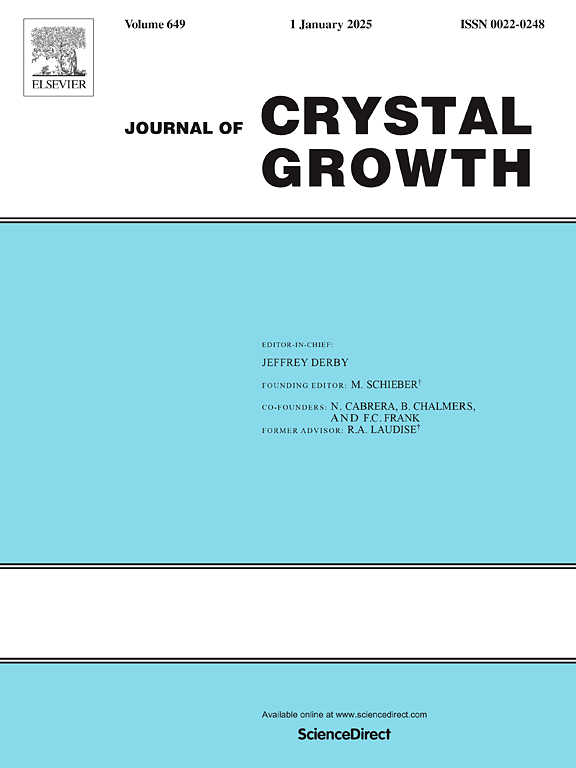Observation-velocity-convergence-based determination of optimal seeding time for sapphire preparation via Kyroupous method
IF 2
4区 材料科学
Q3 CRYSTALLOGRAPHY
引用次数: 0
Abstract
High-quality seeding operations are crucial for ensuring the preparation of high-quality sapphire single crystals, in which the accurate determination of seeding timing is a key issue. However, existing detection methods possess limitations in obtaining sufficient feature points, assessing single feature dimension, and tracking spoke motion on the melt surface. To address these challenges, this study proposes an observation-velocity-convergence method to detect the optimal timing for crystal seeding. The industrial charge coupled device sensors replace eyes of skilled workers to observe in this method. This strategy involves applying an edge detection algorithm to analyze the surface texture of the sapphire melt, optimizing the non-maximum suppression process to increase the number of feature points to 10. Non-uniform sampling is employed to select key frames and extract relevant information about features. The stability of data is assessed by analyzing changes in adjacent angles of characteristic points on the melt surface, followed by determining the best seeding timing using a speed fitting model. This approach not only enhances the dimensional aspect of detecting seeding timing but also improves accuracy while expediting detection rate and reducing data redundancy. Experimental results demonstrate that this strategy increases Class A seed crystal seeding success percentage by 3.3% while reducing seeding time by approximately 0.2 h.

基于观察-速度收敛的Kyroupous法制备蓝宝石最佳播种时间的确定
高质量的播种操作是保证制备高质量蓝宝石单晶的关键,其中播种时间的准确确定是关键。然而,现有的检测方法在获取足够的特征点、评估单个特征维度以及跟踪熔体表面辐条运动方面存在局限性。为了解决这些挑战,本研究提出了一种观测-速度收敛方法来检测晶体播种的最佳时机。在这种方法中,工业电荷耦合器件传感器取代了熟练工人的眼睛来观察。该策略包括应用边缘检测算法分析蓝宝石熔体的表面纹理,优化非最大抑制过程,将特征点数量增加到10个。采用非均匀采样选择关键帧,提取特征的相关信息。通过分析熔体表面特征点相邻角度的变化来评估数据的稳定性,然后利用速度拟合模型确定最佳播种时间。该方法不仅提高了检测播种时间的维度,而且在提高检测率和减少数据冗余的同时提高了准确性。实验结果表明,该策略使A类种子晶体播种成功率提高3.3%,播种时间缩短约0.2 h。
本文章由计算机程序翻译,如有差异,请以英文原文为准。
求助全文
约1分钟内获得全文
求助全文
来源期刊

Journal of Crystal Growth
化学-晶体学
CiteScore
3.60
自引率
11.10%
发文量
373
审稿时长
65 days
期刊介绍:
The journal offers a common reference and publication source for workers engaged in research on the experimental and theoretical aspects of crystal growth and its applications, e.g. in devices. Experimental and theoretical contributions are published in the following fields: theory of nucleation and growth, molecular kinetics and transport phenomena, crystallization in viscous media such as polymers and glasses; crystal growth of metals, minerals, semiconductors, superconductors, magnetics, inorganic, organic and biological substances in bulk or as thin films; molecular beam epitaxy, chemical vapor deposition, growth of III-V and II-VI and other semiconductors; characterization of single crystals by physical and chemical methods; apparatus, instrumentation and techniques for crystal growth, and purification methods; multilayer heterostructures and their characterisation with an emphasis on crystal growth and epitaxial aspects of electronic materials. A special feature of the journal is the periodic inclusion of proceedings of symposia and conferences on relevant aspects of crystal growth.
 求助内容:
求助内容: 应助结果提醒方式:
应助结果提醒方式:


